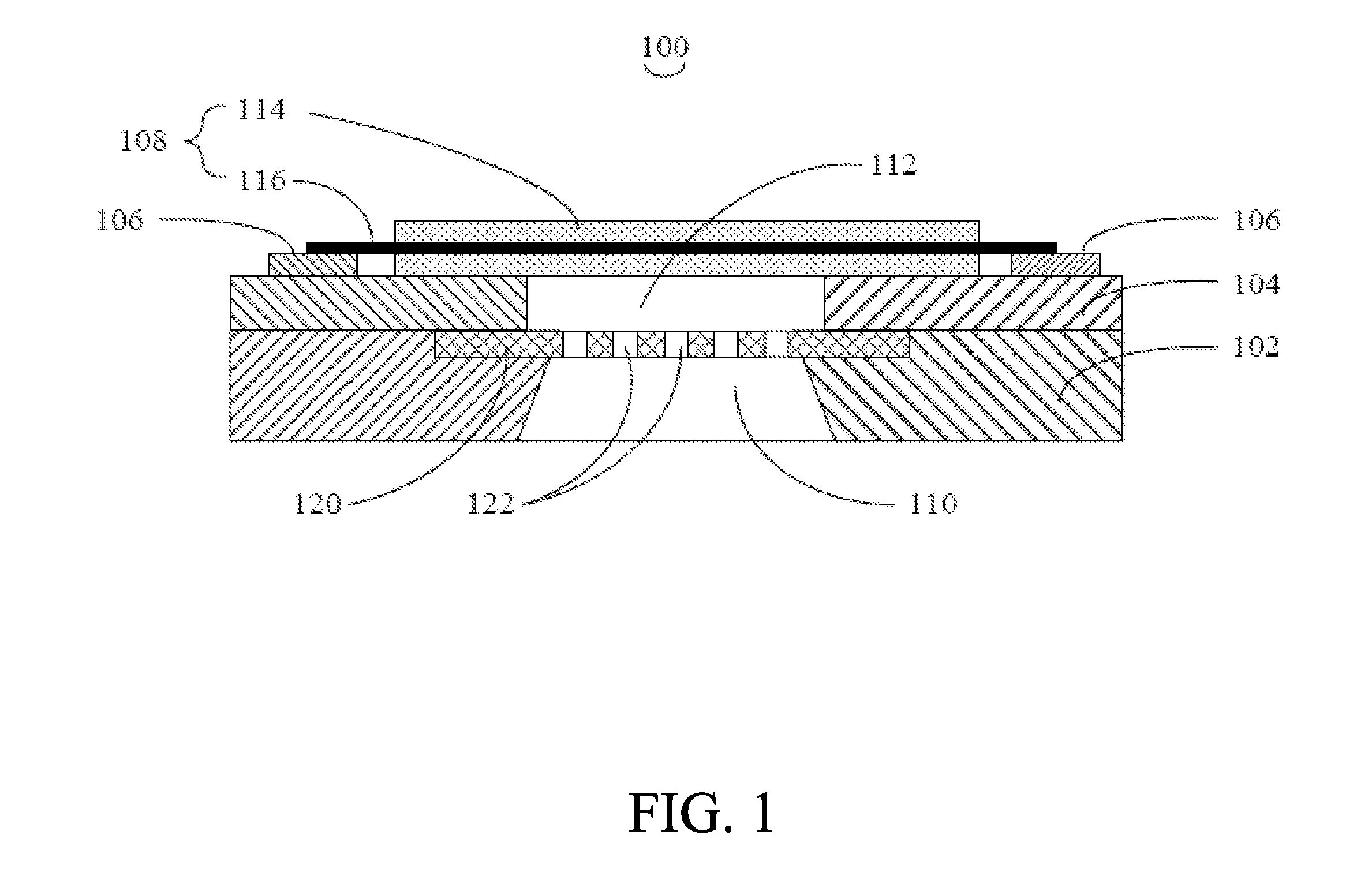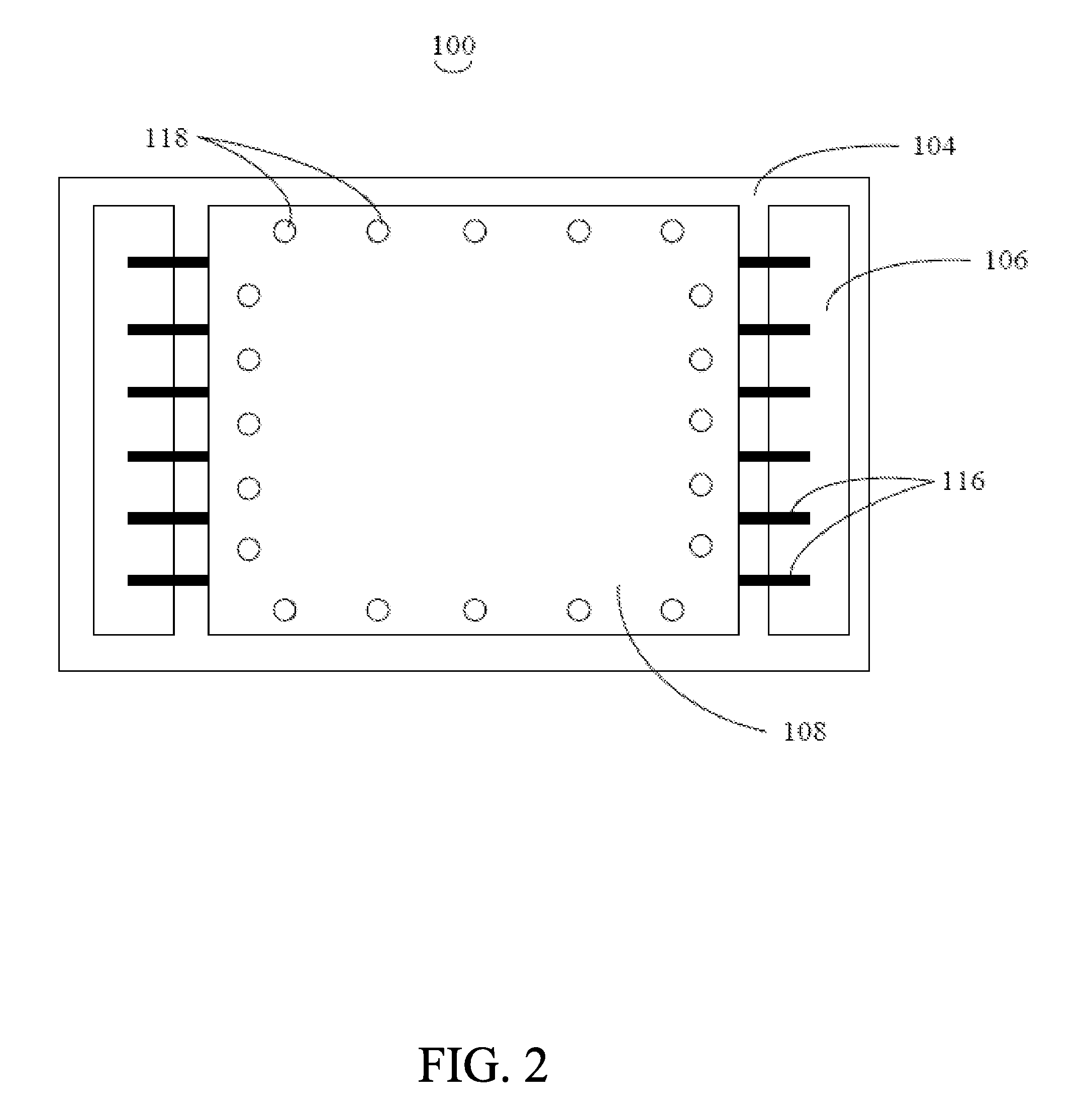Micro-electro-mechanical pressure sensor
a micro-electro-mechanical and pressure sensor technology, applied in the direction of fluid pressure measurement, measurement devices, instruments, etc., can solve the problems of increasing the cost, complicated circuits of micro-electro-mechanical (i.e., mem) pressure sensors, and small voltage-loading capability of sensing parts
- Summary
- Abstract
- Description
- Claims
- Application Information
AI Technical Summary
Benefits of technology
Problems solved by technology
Method used
Image
Examples
first embodiment
[0020]Referring to FIGS. 1 and 2, a pressure sensor 100 is provided in the The pressure sensor 100 includes a substrate 102, a dielectric isolation layer 104, two electrodes 106, and a vibrating membrane 108. The dielectric isolation layer 104 is formed on the substrate 102. The electrodes 106 and the vibrating membrane 108 are disposed on the dielectric isolation layer 104.
[0021]The substrate 102 is composed, at least, of one or more semiconductor materials. A material of the substrate is selected from a group consisting of doped n-type silicon, p-type silicon, and intrinsic silicon. Further, an acoustic cavity 110 is formed by etching on a backside of the substrate 102. The acoustic cavity 110 is configured for enhancing the sensitivity of the pressure sensor 100.
[0022]The dielectric isolation layer 104 includes a through hole 112. The through hole 112 is disposed so as to coincide / align with the acoustic cavity 110. Quite usefully, the material of the dielectric isolation layer ...
seventh embodiment
[0035]A pressure sensor (not shown) is provided in a The pressure sensor is similar to the above-described pressure sensor. But, the vibrating membrane includes a plurality of super-aligned arrays of carbon nanotubes or other arrays of carbon nanotubes. Each of the arrays of carbon nanotubes includes a plurality of oriented carbon nanotubes. The oriented carbon nanotubes in all the arrays of carbon nanotubes are parallel to each other. Changes of pressure on the vibrating membrane cause deformation of the arrays of carbon nanotubes along an axis of the arrays of carbon nanotubes, thereby causing changes of resistance therein. The changes of resistance are detected by an external circuit, which is connected to the array of carbon nanotubes. As such, mechanical deformation of the vibrating membrane is changed into electrical signals. The electrical signals are output by the external circuit.
eighth embodiment
[0036]A pressure sensor (not shown) is provided in an The pressure sensor is similar to the above-described pressure sensor. In this embodiment, though, the carbon nanotube structures of the vibrating membrane are carbon nanotube films. The carbon nanotube films are separately arranged in parallel on a same plane. Each of the carbon nanotube films includes a plurality of carbon nanotube bundles. Each of the carbon nanotube bundles includes a plurality of carbon nanotubes arranged in a preferred orientation. Adjacent carbon nanotube bundles are combined by van der Waals attractive force to connect with each other. Quite suitably, the orientations of carbon nanotube bundles in all the carbon nanotube films are parallel. Changes of pressure on the vibrating membrane cause deformation of the carbon nanotube films along an axis of the carbon nanotube films, thereby causing changes of resistance therein. The changes of resistance are detected by an external circuit, which is connected to...
PUM
| Property | Measurement | Unit |
|---|---|---|
| angle | aaaaa | aaaaa |
| thickness | aaaaa | aaaaa |
| angle | aaaaa | aaaaa |
Abstract
Description
Claims
Application Information
 Login to View More
Login to View More - R&D
- Intellectual Property
- Life Sciences
- Materials
- Tech Scout
- Unparalleled Data Quality
- Higher Quality Content
- 60% Fewer Hallucinations
Browse by: Latest US Patents, China's latest patents, Technical Efficacy Thesaurus, Application Domain, Technology Topic, Popular Technical Reports.
© 2025 PatSnap. All rights reserved.Legal|Privacy policy|Modern Slavery Act Transparency Statement|Sitemap|About US| Contact US: help@patsnap.com



